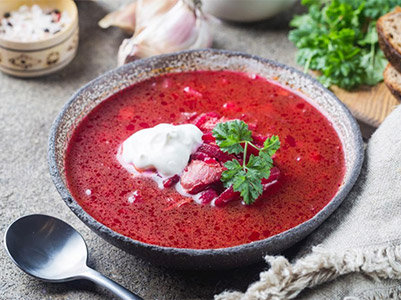 27.11.2023
Ukraine’s National Soup
27.11.2023
Ukraine’s National SoupBorshch
Former Soviet republics, as well as traditional Jewish cuisine, have adopted borshch, but the soup whose base is a broth of beets and other vegetables originated in Ukraine. A Ukrainian woman’s cooking is often judged by her borshch. There are endless regional variations of borshch: the broth may be clear before the customary dollop of sour cream is added and muddies it; or the soup may be thick like’stew and overflowing with ruby-red beets, onions, cabbage, carrots, beans, and potatoes, each depending on local availability and tastes. Some borshch has a hunk of meat tossed in for flavoring. There are hot and cold varieties of borshch, as well as green borshch. Garlic and dill are especially popular seasonings in Ukraine and are used to flavor its national soup. Parsley is often added. Vegetable-based kvas is used extensively as stock for soups, stews, and sauces; and kvas from beets lends a delicious tangy flavor to borshch.
Borshch is a first course in Ukraine, not an entree. It may follow appetizers or be served in place of them. Pampushky are often served with borshch; these are fresh rolls, sometimes resting soggily in a saucer of crushed garlic and oil. It is especially delicious when the garlic mixture is served on the side in a gravy boat. A pampushka can also be a jam- or fruit-filled roll.
Like beet kvas, fermented cabbage is another staple in Ukrainian kitchens because of its tartness, texture, and storage capability. Kapusta means “cabbage,” and kapusniak is a cabbage soup with many variations. Made from fresh or brined cabbage, it might be thin like broth or thick like stew.
Wheat is concentrated in the central steppes of Ukraine, but buckwheat is especially popular in the north. Kasha is porridge made from buckwheat. Buckwheat is actually a fruit, but it is generally prepared like grain. In the higher-altitude Hutsul and Boiko regions, corn and barley are harvested, and they influence regional diets. Potatoes are commonly associated with Ukrainian cooking, but before the 19th century the potato was scarcely used.
Another popular soup is solyanka, which is typically thick and mildly spiced. Myasna and ribna (meaning “meat” and “fish,” respectively) are typical solyanky.
-
 27.02.2024
World of pysanka
Embark on a journey into the captivating world of Pysanka, the Ukrainian...
27.02.2024
World of pysanka
Embark on a journey into the captivating world of Pysanka, the Ukrainian...
-
 29.01.2024
Exploring the Treasures of Kyiv’s Lavra Monastery
In the heart of Kyiv lies the venerable Lavra Monastery, a testament...
29.01.2024
Exploring the Treasures of Kyiv’s Lavra Monastery
In the heart of Kyiv lies the venerable Lavra Monastery, a testament...
-
 13.01.2024
Kachanivka, Eden on Earth
Rich in history, it hosted renowned artists, notably poet Taras Shevchenko.
13.01.2024
Kachanivka, Eden on Earth
Rich in history, it hosted renowned artists, notably poet Taras Shevchenko.

